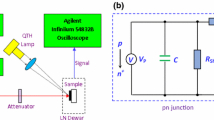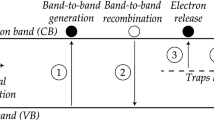Abstract
It has been shown that the time evolution of a photocurrent under the conditions of the irradiation of a photochromic molecule by moderate-intensity light includes the fast and slow stages of the kinetic process. The fast stage corresponds to an increase in the current and is associated with the charging of the molecule, which is in a singlet excited state after a phototransition. The slow stage includes electron transfer between electrodes involving both charged and excited (singlet and triplet) states of the molecule. When the exchange interaction of unpaired electrons on the HOMO and LUMO levels of the photoexcited molecule is weak, the steady-state photocurrent is close in magnitude to the maximum transient current, whereas the steady-state current is suppressed when the exchange interaction is strong. The reason is that a molecule in the triplet state can block electron transfer between electrodes. The conditions have been found under which such blocking is a manifestation of the peak transient photocurrent that is formed immediately after the beginning of the irradiation of the molecule.
Similar content being viewed by others
References
Molecular Electronic Devices, Ed. by F. L. Carter (Marcel Dekker, New York, 1982).
A. J. Aviram, Am. Chem. Soc. 110, 5687 (1988).
V. Mujica, M. Kemp, and M. Ratner, J. Chem. Phys. 101, 6849 (1994).
E. G. Petrov, I. S. Tolokh, A. A. Demidenko, and V. V. Gorbach, Chem. Phys. 193, 237 (1995).
S. Datta, Electron Transfer in Mesoscopic Systems (Cambridge Univ. Press, Cambridge, 1995).
E. G. Petrov, Ukr. J. Phys. 43, 1630 (1998).
A. Nitzan, Ann. Rev. Phys. Chem. 52, 681 (2001).
M. Galperin, M. A. Nitzan, and A. Ratner, J. Phys.: Condens. Matter 19, 103201 (2007).
F. Chen and N. J. Tao, Acc. Chem. Res. 42, 429 (2009).
P. Hänggi, M. Ratner, and S. Yaliraki, Chem. Phys. 281, 111 (2002).
G. Cuniberti, G. F. Fagas, and K. Richter, Lecture Notes Phys. 680, 1 (2005).
E. G. Petrov and M. V. Koval, Phys. Lett. A 372, 5651 (2008).
E. G. Petrov, Ukr. J. Phys. 56, 721 (2011).
E. G. Petrov, Chem. Phys. 326, 151 (2006).
E. G. Petrov, V. May, and P. Hänggi, Phys. Rev. B 73, 045408 (2006).
S. Yasutomi, T. Morita, Y. Imanishi, and S. Kimura, Science 304, 5679 (2004).
B. Leea, S. Takedaa, K. Nakajimab, et al., Biosensors Bioelectron. 19, 10 (2004).
C. B. Winkelmann, I. Ionica, X. Chevalier, et al., Nano Lett. 7, 1454 (2007).
A. S. Kumar, T. Ye, T. Takami, et al., Nano Lett. 8, 1644 (2008).
S. J. van der Molen, J. Liao, T. Kudernac, et al., Nano Lett. 9, 76 (2009).
J. Lehmann, S. Kohler, V. May, and P. Hänggi, J. Chem. Phys. 121, 2278 (2004).
M. Galperin and A. Nitzan, Phys. Rev. Lett. 95, 206802 (2005).
B. D. Fainberg, M. Jouravlev, and A. Nitzan, Phys. Rev. B 76, 245329 (2007).
J. Buker and G. Kirchenow, Phys. Rev. B 78, 125107 (2008).
E. G. Petrov, V. O. Leonov, V. May, and P. Hänggi, Chem. Phys. 407, 53 (2012).
V. M. Yashchuk, V. G. Syromyatnikov, T. Yu. Ogul’chansky, et al., Mol. Cryst. Liq. Cryst. 353, 287 (2000).
E. G. Petrov, Ye. V. Shevchenko, V. May, and P. Hänggi, J. Chem. Phys. 134, 204701 (2011).
L. I. Glazman and M. Pustilnik, in Nanophysics: Coherence and Transport, Ed. by H. Bouchiat, Y. Gefen, S. Gueron, et al. (Elsevier, Amsterdam, 2005), p. 427.
L. Wang and V. May, Chem. Phys. 375, 252 (2010).
H. Park, J. Park, A. Lim, et al., Nature 407, 57 (2000).
A. Honciuc, A. Jaiswal, A. Gong, et al., J. Phys. Chem. B 109, 857 (2005).
R. M. Metzger, Lect. Notes Phys. 680, 313 (2005).
Author information
Authors and Affiliations
Corresponding author
Additional information
Original Russian Text © V.A. Leonov, E.G. Petrov, 2013, published in Pis’ma v Zhurnal Eksperimental’noi i Teoreticheskoi Fiziki, 2013, Vol. 97, No. 9, pp. 634–641.
Rights and permissions
About this article
Cite this article
Leonov, V.A., Petrov, E.G. Peak and steady-state photocurrents in a molecular diode. Jetp Lett. 97, 549–556 (2013). https://doi.org/10.1134/S0021364013090087
Received:
Accepted:
Published:
Issue Date:
DOI: https://doi.org/10.1134/S0021364013090087




